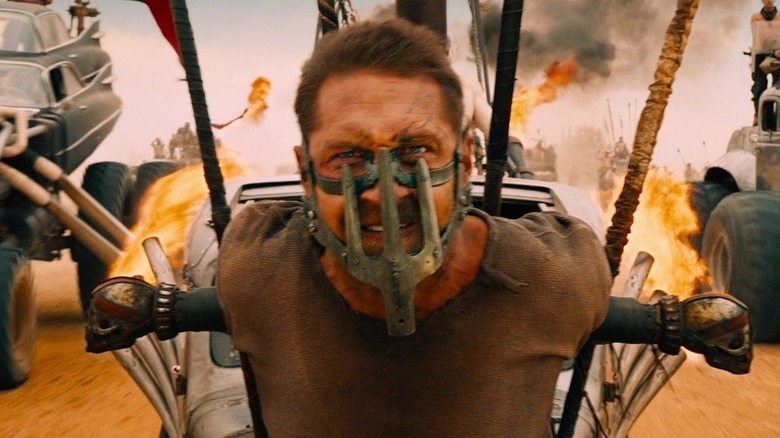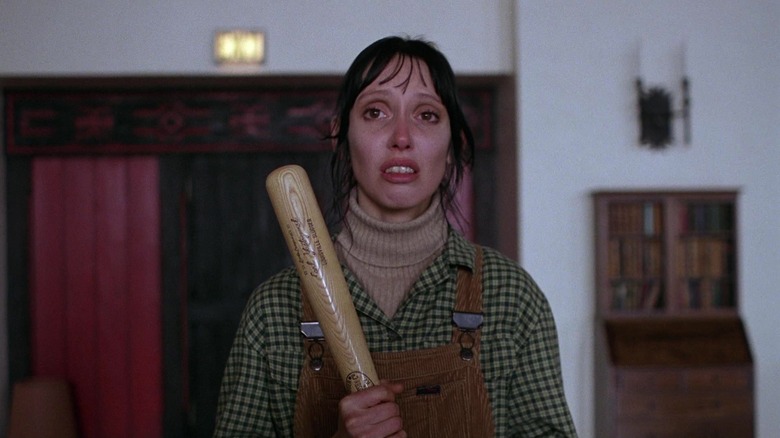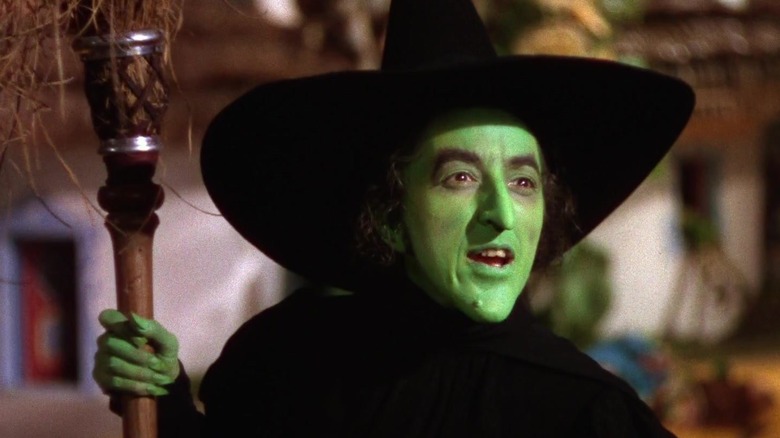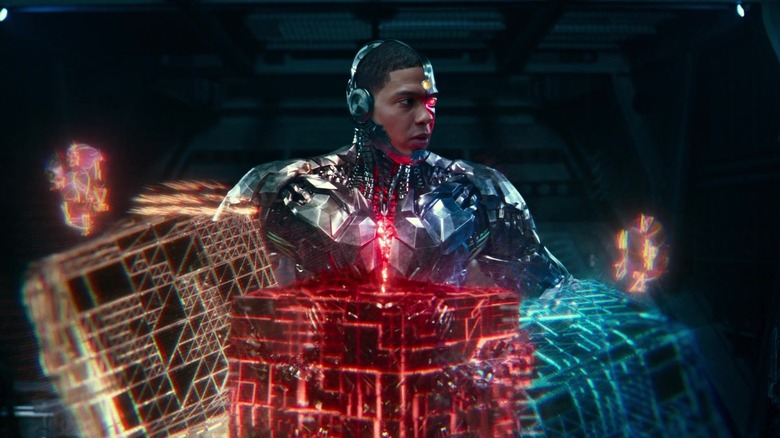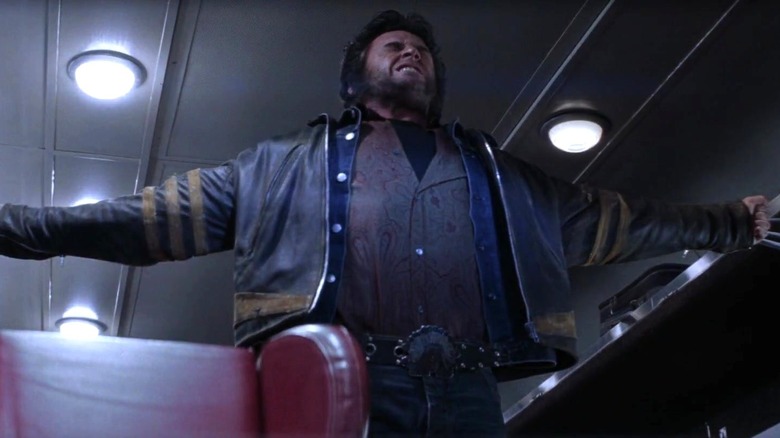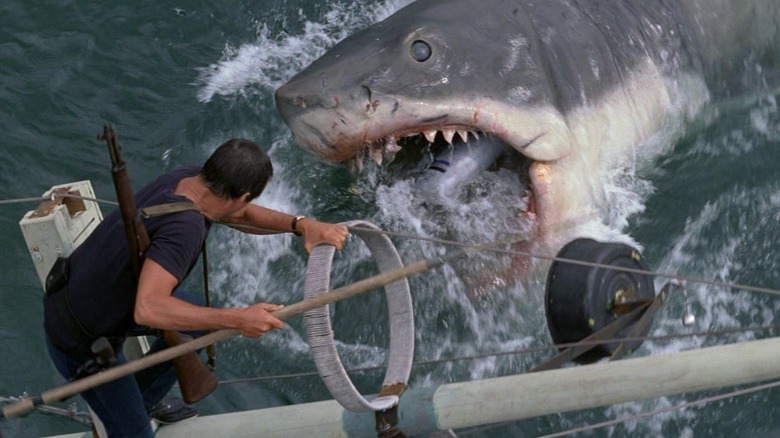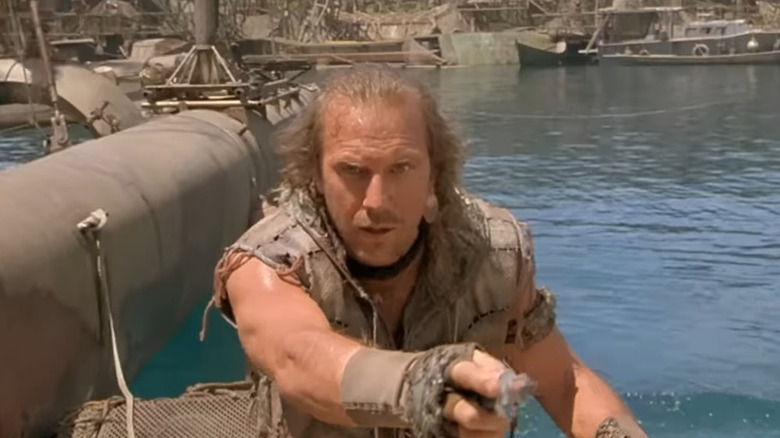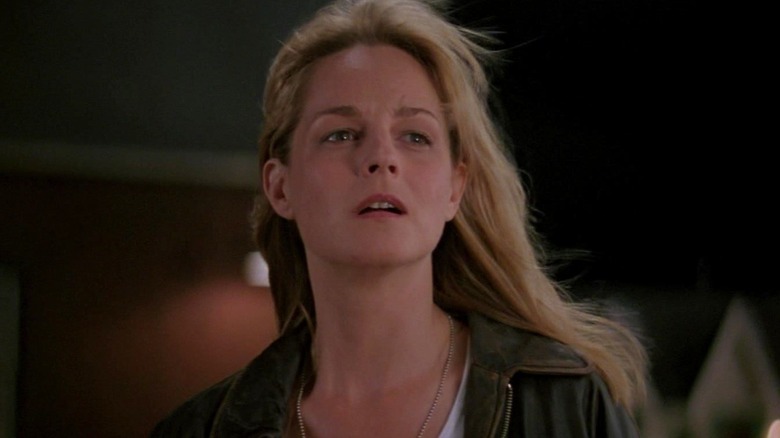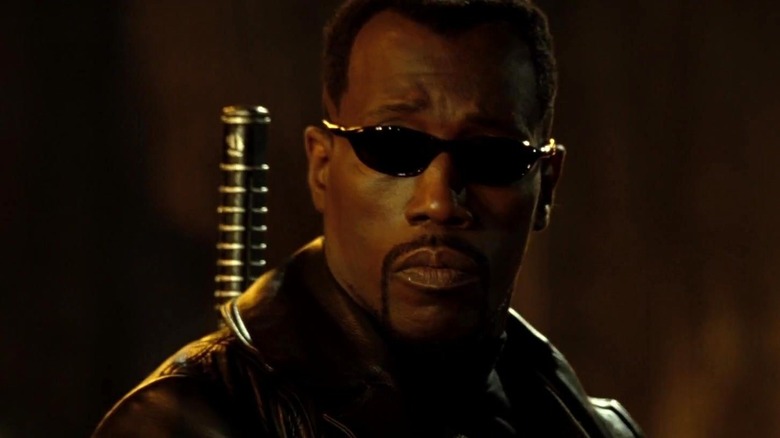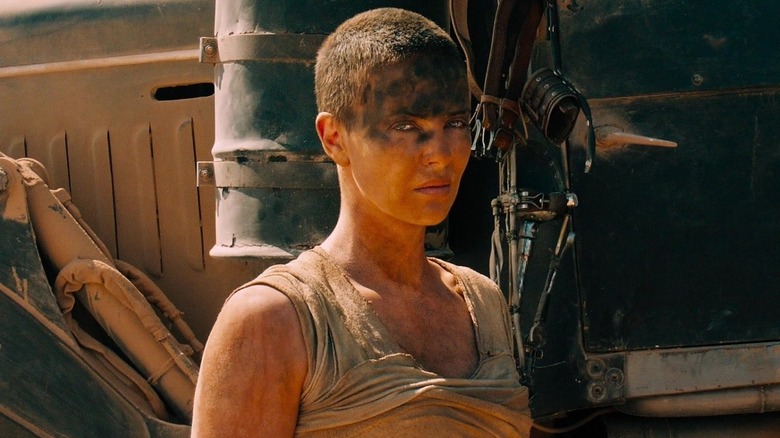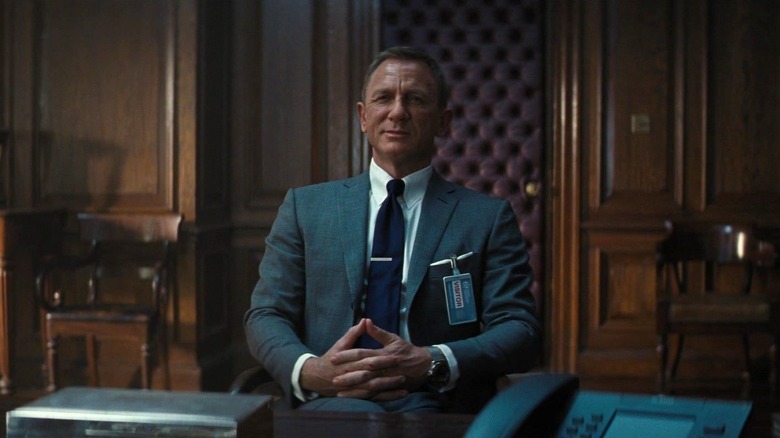Famous Movies That Were Worse Than You Realized Behind The Scenes
Anyone who has worked in the film industry will tell you that making a movie is challenging and hard work. Not everything goes according to plan, as schedules clash, productions run over their allocated time, producers pass notes, and some shots fail to work even though they look ideal on the storyboard. That being said, there have been famous movie sets that were worse than anyone could have imagined behind the scenes.
Take "The Shining" as a prime example. While everyone knows that director Stanley Kubrick's on-set behavior pushed his actors to the limits, demanding at least 30 takes per scene, Shelley Duvall was put through an emotional wringer for her role as Wendy Torrance in the horror movie. Also, as fun as John McTiernan's "Predator" looks on the surface level, it wasn't such a simple production to bring to life — especially after the original actor who played the intergalactic trophy hunter departed the classic action film due to dissatisfaction.
The moral of the story is that people go through a lot to bring entertainment to the audience. Sometimes, though, we have to ask the question: how far is too far? Let's take a look at the movies in which the issues behind the scenes were even wilder than what made it onto our screens.
Shelley Duvall experienced a taxing time making The Shining
As it stands, Stanley Kubrick's "The Shining" is emotionally draining from the storyline alone. Based on the 1977 Stephen King novel of the same name, the film follows the descent into madness of Jack Torrance (Jack Nicholson) in the haunted Overlook Hotel, as he turns on and torments his wife, Wendy (Shelley Duvall), and son, Danny (Danny Lloyd).
Playing Wendy required Duvall to be in numerous intense scenes, screaming, crying, or running away from Nicholson's axe-wielding character. As revealed in Vivian Kubrick's documentary "The Making of the Shining" (via The Vintage News), Stanley Kubrick intentionally prodded and provoked Duvall to get a reaction out of her, criticizing her as an actor and telling the cast and crew not to sympathize with her after filming harrowing scenes. Reportedly, Kubrick forced her to do the famous baseball bat scene 127 times, which turned Duvall into an emotional mess by the end.
In an interview with The Hollywood Reporter in 2021, Duvall confirmed that Kubrick had pushed her to the extreme, but she also stated that he had been "very warm and friendly." However, there was no getting around the fact that it was a taxing shoot, and "The Shining" remains one of the movies that went too far. "[Kubrick] doesn't print anything until at least the 35th take," Duvall said. "Thirty-five takes, running and crying and carrying a little boy, it gets hard. And full performance from the first rehearsal. That's difficult."
Margaret Hamilton burned for The Wizard of Oz
Victor Fleming's "The Wizard of Oz" wowed audiences when it arrived in 1939, but it wasn't an all-round good experience for Margaret Hamilton, who played the Wicked Witch of the West, and stuntperson Betty Danko. As per Aljean Harmetz's "The Making of The Wizard of Oz," the appearance of the Witch in Munchkinland resulted in injuries for both performers. In Danko's case, she was meant to catapult into the picture from a hidden pit. After the fire and smoke exploded, an aluminum roof would open, and Danko would appear as the Witch. Unfortunately, a dance director fell through the aluminum roof and injured Danko's shoulders. After this, the setup for the stunt was adjusted.
The next part of the scene required Hamilton's Witch to give a speech and then depart, so a decision was taken for Danko to teach Hamilton how to complete the stunt safely. It still had dangerous elements, so they rehearsed the sequence to ensure that Hamilton could do it. After the first take went well, Fleming insisted on filming it one more time. The cast and crew broke away for lunch, then when they came back, they couldn't get the shot right. This irritated the director, who insisted they do it again and again. On another take, the flame and smoke effects arrived sooner than expected, burning Hamilton. The actor experienced severe burns, with the damage on her hand being described as having no skin from her wrist to her fingernails.
Ray Fisher accused Joss Whedon of misconduct on the Justice League set
The journey to 2017's "Justice League" featured turbulence every step of the way. Director Zack Snyder didn't see out the entire production, as he left the film after a personal tragedy. Filmmaker Joss Whedon stepped in to finish the remainder of the movie; however, the final product boasted a mishmash of tonal clashes, arguments over whose movie this really was, and the infamous digital erasure of Henry Cavill's mighty mustache, which turned his Superman into the human version of Shrek on screen.
According to Ray Fisher, who plays Cyborg in "Justice League," there was more that occurred behind the scenes of this superhero film. Posting on his now-deleted X account (via The Hollywood Reporter), Fisher slammed Whedon's behavior, writing, "[Whedon's] on-set treatment of the cast and crew of 'Justice League' was gross, abusive, unprofessional, and completely unacceptable. He was enabled, in many ways, by [producers] Geoff Johns and Jon Berg."
Other "Justice League" castmates like Jason Momoa and Gal Gadot expressed their support of Fisher's comments, echoing that the production hadn't been the best of times for them either. Whedon defended himself from the allegations to Vulture. In response, Warner Bros. undertook an investigation and said that "remedial action has been taken" (via Variety) but the studio declined to list the specifics.
The actors threatened to walk off the X-Men set
The truth of the Marvel Cinematic Universe is that it wouldn't exist without 2000's "X-Men" movie. It also turned Bryan Singer into an in-demand director in Hollywood because of his ability to turn a superhero property into a mega-money hit for studio execs. In the years since the film's release, allegations have surfaced about Singer's on-set behavior. In 2020, The Hollywood Reporter published an extensive piece, including commentary from those who worked with Singer on "X-Men," detailing a production rife with unprofessionalism and shocking behind-the-scenes stories.
Reportedly, Singer displayed erratic behavior, often arriving late and moody on set. On one particular day, writer and executive producer Tom DeSanto attempted to shut down the production after suspecting Singer was under the influence, as well as other crew members. The pair had a bust-up, but Singer continued to shoot, resulting in Hugh Jackman being injured during a stunt when a stunt coordinator wasn't present. Producer Ralph Winter officially shut down the production after this, while the studio wanted DeSanto to leave the production.
According to sources, the "X-Men" cast members all approached Singer's trailer, telling the director they would leave the production if DeSanto was let go. DeSanto didn't comment on the incident, but Singer's representatives denied this version of events.
Steven Spielberg regretted shooting Jaws on the water
How difficult can it be for a movie featuring a prop shark to be filmed in the water? Very. While Steven Spielberg's 1975 classic "Jaws" redefined what blockbuster cinema is, it was a production that had everyone tearing out their hair.
In "The Shark Is Still Working" documentary, Spielberg stated that making "Jaws" was still the most difficult film he's ever worked on. "Nothing's ever come close to the production difficulties of shooting an actual special effects movie," he said. "Not a digital effects movie that was many, many years later, but a mechanical effects movie. Not in a tank somewhere in Malta, or some safe tank somewhere in Florida, but in the actual Atlantic Ocean. We must have been complete idiots to have even expected to have an easy ride ..."
According to The Washington Post, the production ran way over time and had everyone wondering if they would even manage to piece together a film. The weird things that happened on the set of "Jaws" included the sharks not holding up, with one of them even sinking to the bottom of the ocean, while the cast and crew struggled to get the right shots with the combination of the misbehaving props and unpredictable waters. Ultimately, this is what resulted in Spielberg getting creative and keeping the shark off-screen for the most part — to drum up the tension and anticipation among the audience, but also to solve a practical problem.
Predator was a jungle of unpredictability
Speak to anyone about which is one of the most defining action films of the '80s, and many cite "Predator." After all, who doesn't love seeing Arnold Schwarzenegger's Dutch Schaefer face off against an alien threat in a jungle? While it looks like a ton of fun, that wasn't always the case for the people making the movie.
In The Hollywood Reporter's oral history of "Predator," a host of revelations came to light about a difficult production. For instance, the entire Mexican crew was replaced, because many of them weren't deemed competent enough. In addition, the jungle proved to be difficult to shoot in — not only because of the soaring temperatures, but also because of the bugs. Then, there was the fact that they were approaching the end of the shoot, but director John McTiernan had only shot half of the movie.
One of the most famous stories from "Predator" was how Jean-Claude Van Damme was the original actor in the Predator suit. However, there are multiple accounts detailing his reasons for leaving the film. According to visual effects supervisor Joel Hynek, the following occurred: "[JCVD] comes in the trailer and Joel [Silver] starts saying, 'You gotta stop kickboxing!' — because [Jean-Claude] wanted to kickbox — and he was telling him, 'Look, the Predator is not a kickboxer.' And Van Damme was like, 'I must do that; that's how I see the Predator.' And Joel said, 'Well, you're fired. Get out of here.'"
Waterworld was nothing short of a nightmare
At the time of its production, "Waterworld" was the most expensive film of all time. On paper, it looked like nothing but a surefire hit, with its combination of water, action, adventure, and Kevin Costner as its lead. However, the film is most remembered for being one of the most troubled Hollywood productions.
Heck, even the Golden Globes website dedicated an entire article to the experience that was "Waterworld." Everything that could go wrong did. A hurricane wrecked a set that needed to be rebuilt, the cast and crew experienced bouts of seasickness, people were stung by jellyfish, and the production ran away from everyone as they discovered how difficult it was to film on water. Costner admitted that Steven Spielberg had advised him to use sets and not shoot on water, after his experience on "Jaws," but Costner didn't heed the esteemed filmmaker's advice.
Apart from all the physical hassles happening in real time, there were serious disagreements about the creative direction of the film. Costner fought with the film's director, Kevin Reynolds, whom he demanded for the role. Ultimately, the pair clashed to the point that Reynolds left the production because he couldn't work with Costner anymore. What made "Waterworld" even worse is how it turned into a box office bomb, so all that struggle was for nothing but dog paddles in the end.
Twister turned into a tornado of behind-the-scenes problems
As far as disaster movies go, you don't get much better than 1996's "Twister," directed by Jan de Bont. The film made everyone fearful of tornadoes and that cows could fly. It wasn't only the drama on screen, though, as the behind-the-scenes shenanigans might have been more of a storm than the actual film.
Speaking to the Independent in 2024, "Twister" stunt coordinator Mic Rodgers unpacked a series of events that had everyone on edge. Rodgers revealed that de Bont actually tried to chase real tornadoes before the filming started, even though none of the footage made it into the final film. In terms of injuries, actor Helen Hunt was concussed by a car door smacking her in the head, while her stunt double cracked a rib. If that wasn't enough, Hunt and Bill Paxton experienced temporary blindness after being exposed to electric lamps, while cinematographer Jack N. Green also ended up in the hospital after a house designed to collapse in a stunt scene did so when he was still inside it.
The one incident that had the crew walking off set, though, occurred after de Bont pushed a camera assistant and refused to apologize. According to Rodgers, this triggered a visit from producer Steven Spielberg. "The ramp came down on the Learjet, and Spielberg walked down it, and he never touched the ground," Rodgers said. "He just stood there yelling at Jan. He never even got off the plane."
David S. Goyer called Blade: Trinity the worst experience
David S. Goyer played an important role in bringing "Blade" to the big screen. Not only did he write all three movies, starring Wesley Snipes as the Daywalker, but he also received the opportunity to direct the third entry, "Blade: Trinity." However, Goyer's venture into the director's chair didn't go very well, as Patton Oswalt, who plays Hedges in the film, revealed.
Oswalt cited a number of disturbing incidents on set, alleging that Snipes strangled Goyer. He stated that Snipes also tried to get Goyer to quit the production. "Wesley sat down with David and was like, 'I think you need to quit. You're detrimental to this movie,'" Oswalt told The A.V. Club. "And David was like, 'Why don't you quit? We've got all your close-ups, and we could shoot the rest with your stand-in.' And that freaked Wesley out so much that, for the rest of the production, he would only communicate with the director through Post-it notes."
In an interview with The Guardian in 2020, Snipes questioned Oswalt's version of events. He explained how he was an executive producer on the film, entitling him to demand changes, while suggesting that he faces "microaggressions" because of his race. Speaking on the "Happy Sad Confused" podcast, Goyer didn't elaborate on the issues too much, but he referred to "Blade: Trinity" as "the worst experience of my career." That said, he still found the time to praise Snipes as an actor.
Charlize Theron and Tom Hardy couldn't work together on Mad Max: Fury Road
George Miller's "Mad Max: Fury Road" remains one of the quintessential action movies of the 21st century — and boasts some of the most awesome car crashes in movie history. Despite all the plaudits, especially for the performances of Tom Hardy as Max Rockatansky and Charlize Theron as Imperator Furiosa, the two leads butted heads behind the scenes.
Author Kyle Buchanan covered the drama in the book "Blood, Sweat, and Chrome: The Wild and True Story of Mad Max: Fury Road" (via Independent), where both Hardy and Theron confirmed there had been a massive blow-up on set between them. The story goes that Hardy showed up on set three hours late, which irked Theron, who exploded into a curse-laden tirade aimed at her co-star and demanded that he be fined for his behavior. Reportedly, Hardy reacted in an aggressive manner, which resulted in Theron asking for producer Denise Di Novi to fly out to the film's set and deal with the issue.
Hardy acknowledged his part in the dispute, stating, "What she needed was a better, perhaps more experienced partner in me. I'd like to think that now that I'm older and uglier, I could rise to that occasion." Theron added that it reached "a place where it was kind of out of hand" and that's why she requested Di Novi's intervention.
No Time to Die shook and stirred the cast and crew
Even before Daniel Craig's last ride as James Bond in "No Time to Die" entered production, the problems started to mount. Director Danny Boyle departed the film in August 2018, with the movie meant to start filming in December of that year. Cary Joji Fukunaga then boarded "No Time to Die" as the director. Naturally, the start and release dates were pushed out to recalibrate this overhaul in creative direction, but this didn't prevent other issues from arising during production.
As per the official James Bond X account, Craig required ankle surgery after an accident on set in May 2019. The production continued, even though Craig was out of action for two weeks to recover from the operation. A few weeks later, the same account revealed that an explosion stunt scene resulted in damage to the set and an injury to one of the crew members.
Regardless of these incidents, Fukunaga and his collaborators pushed to meet the 2020 release date. Then, an event outside of anyone's control occurred in the year as they prepared for the film's release: the COVID-19 pandemic. Resultantly, "No Time to Die" delayed its release date to late 2021 — seemingly proving that no one wanted to see 007 die here.
Want to read about more movie mayhem? Check out the bizarre things that happened on the set of Tim Burton movies.
